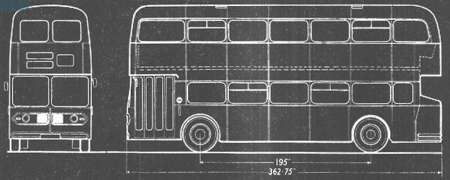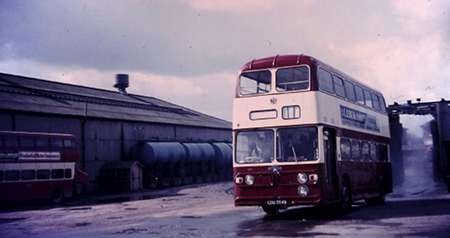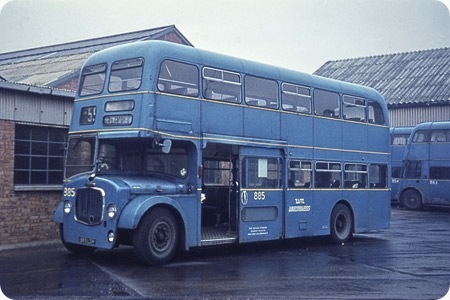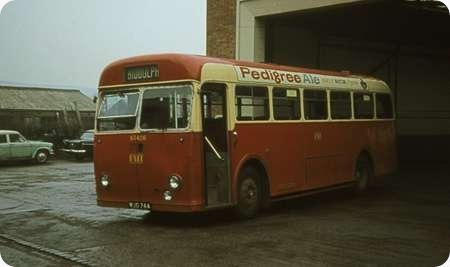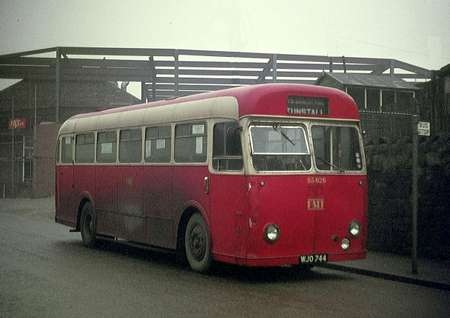Coventry Corporation – Leyland Atlantean – CDU 348B – 348
Coventry Corporation
1965
Leyland Atlantean PDR1/2
Willowbrook H44/32F
This is one of a batch of 22 very contentious Leyland Atlanteans with Willowbrook H44/32F bodies delivered to Coventry Transport in January 1965, the issue being that they were Leylands delivered to the home city of Daimler who since the war had been almost the only supplier of buses to the company. The order may have been made to apply some pressure to Daimler for some reason which appears to have been successful as a similar batch of Fleetlines with near identical bodies were delivered within six months these were followed by more Fleetlines with ECW and then East Lancs bodies until the mid seventies, I think one of the Atlanteans appeared at the 1964 Earls Court show.
Photograph and Copy contributed by Diesel Dave
20/07/14 – 17:32
In Commercial Motor magazine dated 11th September 1964 the following report was published.
"Leyland Motors Ltd. has introduced a new version of the Atlantean rear-engined chassis which is fitted with a drop-centre rear axle, permitting a straight-through, stepless gangway in the lower saloon.
Delivery is now being made to Coventry Corporation of 22 buses of this type, fitted with 76-seat bodies by Willowbrook Ltd. Overall height of the new vehicles is 14 ft. 0 in. unladen, 4 in, less than the normal ‘highbridge’ Atlantean, yet ample headroom is still provided in each saloon.
One of Coventry’s new Atlanteans will be shown on the Willowbrook stand at the Commercial Motor Show, and several other examples employing the new chassis will also be seen. Side and front elevations of the new Willowbrook bodied Atlantean are shown in the accompanying drawing. Ample luggage space is a feature of this body."
Stephen Howarth
21/07/14 – 07:26
Dave, if your theory is correct then the issue with Daimler may well have been price. I have heard that Salford’s change of allegiance from Daimler to Leyland in 1963 was for that reason, although they of course never went back.
Peter Williamson
21/07/14 – 07:27
Could the idea be sold in Coventry, then, Stephen, because the Atlanteans had Daimler running gear and the great BL meltdown had begun? Or am I wrong?
These do look like uglibus candidates- I haven’t seen one, but Yorkshire Traction had some…. www.flickr.com/photos/
The glass fibre fronts & domes look like add on body kits. Interestingly the Coventry examples look distinctly under ventilated, whilst Tracky go to the other extreme.
Joe
21/07/14 – 07:29
These Atlanteans were of the newly introduced PDR1/2 model which was fitted with a Daimler dropped centre rear axle and gearbox, which was intended to facilitate lowheight bodywork without the need for a sunken side gangway at the rear, which was a feature of early lowbridge Atlanteans based on the PDR1/1 model. I don’t think Coventry had any need of lowbridge vehicles, but the inclusion of Daimler components would have standardisation benefits when the fleet later included Fleetlines. Presumably this was always the intention. Manchester Corporation also bought the PDR1/2 model (132 of them) alongside their 130 Fleetlines with MCW "Orion" bodies. I always thought these had a rather odd mixture of sound effects.
Many years later, I would drive Daimler Fleetlines with Leyland Engines (bought by Crosville from Southdown) which felt more like Atlanteans than Fleetlines, the engine sound on these tended to dominate the gearbox sound. These buses also had direct air gearchange and a step from the platform to the lower deck – both "Atlanteanish" features.
I thought these Willowbrook bodies were a very attractive design, enhanced by the Coventry livery. They introduced a more conventionally shaped service number blind, after years of the rather odd arrangement with equally sized and shaped destination and service number screens.
Don McKeown
21/07/14 – 15:21
At the time of the order Daimler was an independent company that was part of the Jaguar group along with Guy. At the time Leyland Motors was a very profitable concern it all went pear shaped after the shot gun marriage between them and BMC in the late sixties. Although Leyland were already being starting to give the industry what they wanted and not the other way round.
Chris Hough
21/07/14 – 15:28
When Coventry issued the tender for this order, they specified a low floor design, presumably thinking that only Daimler could deliver such a vehicle. However Leyland, no doubt spotting the opportunity to sell to Daimler’s home city hastily put together their own low floor design. They won the order on price but delivery was delayed by development problems. This is not the livery that these buses carried at delivery. The maroon was originally only applied to the lower skirt, a band above the lower windows, another below the upper windows and the roof. The destination blinds also differed, as shown on the blueprint image.
John McSparron
22/07/14 – 06:53
The Yorkshire Traction vehicle shown in the link above was one of four that were diverted from a Devon General order, indeed they entered service in Devon General livery and ran in that form for some time.
Before eventually finishing up in the nondescript NBC colours shown in the photo they did run in traditional YTC Livery of BET crimson and light cream, a combination that really suited this bodywork.
Andrew Charles
22/07/14 – 06:54
Most sources say that although the PDR1/2 did have a Daimler gearbox, the drop-centre rear axle was the Albion Lowlander unit rather than the one from the Fleetline.
With regard to the odd sound effects in Manchester, the only engine officially offered in the PDR1/2 was the O600, since the Daimler gearbox, at that early stage in its history, couldn’t take the extra torque of the O680 in Atlantean fettle. However, Manchester wanted O680 engines for durability rather than extra power, and specified a specially derated version at 130bhp. This may account for their subdued and breathy engine note, which allowed the gearbox to sing more prominently than in some other applications.
Peter Williamson
I am sure that Peter W is correct that the PDR1/2 was fitted with a Daimler (‘Daimatic’) gearbox, but not axle.
Further to Don McK, I don’t recall that the inclusion of a Daimler gearbox in the PDR1/2 was a consideration in the decision to buy it – the decision was based solely upon a significantly lower tender price from Leyland, and, even then, the order was placed only after furious council debate.
I’ve always presumed that Leyland deliberately tendered low in order to capitalise on the potential publicity, and this it certainly did – for several months, for instance, there was a standing advertisement on the rear cover of ‘Buses Illustrated’, the message of which was ‘Coventry, home to the British motor industry, chooses Leyland..’, or words to that effect. Leyland did, at least, acknowledge that Coventry, and not Leyland, was home to the British motor industry, and its advertising strategy seems to have failed to impress, since I think the Fleetline comfortably outsold the PDR1/2, the latter proving problematic.
David Call
25/07/14 – 12:19
This style of body by Willowbrook had a very long life it was used as late as 1976 to re-body a bus damaged in the Derby depot fire.
Chris Hough
26/07/14 – 06:42
I would challenge the theory that the Daimler gearbox in the Atlantean PDR1/2 could not cope with the torque of the O.680 engine. At that time, the standard Atlantean setting for the O.680 was 150 bhp at 2000 rpm, with a maximum torque of 485 lb ft at 1000 rpm. The corresponding figures for the contemporary 6LX were 150 bhp at 1700 rpm, and 485 lb ft torque at 1050 rpm. Thus the Gardner delivered identical output at rather lower rpm. Any derating of the O.680 in the Atlantean PDR1/2 must have been undertaken for economy reasons, bearing in mind that the Leyland engine required an extra 300 rpm to produce the same power as the Gardner. Reducing the governed speed of the O.680 to 1700 rpm would have reduced the output to 130 bhp.
Roger Cox
27/07/14 – 06:41
I don’t think any early Fleetlines had 6LXs rated at 150bhp. Manchester’s were rated at 132bhp, presumably with a corresponding reduction in torque, and I thought at the time that that was the standard Fleetline rating. But if the reduction in the O.680’s power was taken care of by simply lowering the governed speed, then I agree that there would be no reduction in torque there.
The idea that the PDR1/2 wasn’t offered with the O.680 option must have come from somewhere, and the Daimler gearbox certainly was strengthened before the CRL6 Fleetline came on the market. Perhaps someone just put two and two together and created a bit of folklore.
Peter Williamson
08/10/15 – 07:13
Talk about being late to the party!
According to "The Leyland Bus Mk2" (D. Jack) page 325, the O.680 engine was "not available in the PDR1/2, owing to torque limitations on the rear axle". The same page confirms it carried the Lowlander rear axle.
Allan White
09/10/15 – 07:18
Better late than never, Allan. All is resolved, I think.
Peter Williamson
20/10/15 – 09:07
The attached photo shows another of the batch 354, CDU 354B in an unusual location at the rear of PMT Clough Street depot in Hanley (note the broken down PMT lowbridge Atlantean in the background.)
The reason was that PMT had recently installed a Dawson ‘Cyclone’ bus interior cleaner at Hanley Depot in an attempt to improve and speed up nightly interior cleaning. The unit was a massive vacuum cleaner with a bellows which was pushed out to the bus entrance by pneumatic rams, it was switched on and hey presto all the loose rubbish within the bus was sucked into the cleaner. A man with an air lance entered by the emergency door and agitated the less willing items of rubbish into the air stream. Coventry were interested in the concept and on 25th March 1971 sent up 354 (maybe with the previous days rubbish still on the bus??) to see how it performed. As the vacuum plant was situated immediately before the bus wash, a trip through the wash was necessary hence the photo.
Ian Wild
21/10/15 – 06:37
Brilliant, Ian!
Pete Davies
23/10/15 – 06:28
It was a long time ago Pete and I can’t remember how reliable the machine was. It can’t have been exclusive to PMT, does anyone know of other Operators who had one? I do recall that we had to cut apertures at odd places inside the buses eg at floor level in the offside partition at the top of the staircase. It can’t have been much fun inside the bus in a force 8 gale!! I don’t recall losing any seat cushions…..
Ian Wild
23/10/15 – 16:37
Trent Motor Traction at Meadow Road Derby, and United Automobile Services had them. Whether this was at all Depots I do not know.
Malcolm Hitchin MBE in his book ‘Keep the Wheels Turning’, recounting his 50 years in Trent engineering, mentions, that very early on after having the system installed, that, if they did not open the emergency door, before starting the vacuum, then it was possible that the pressure from the vacuum could suck in the bus windows.
Stephen Howarth
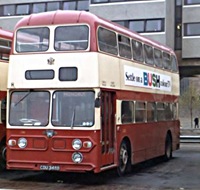 Vehicle reminder shot for this posting
Vehicle reminder shot for this posting
12/11/15 – 14:23
Think these units actually had a self changing gear semi automatic box not a Daimatic.
Reason for the purchase of Leylands was that Daimler thinking they had a monopoly put in a price and refused to negotiate even when Leyland put the lower price in. There was much heated debate in the Council Transport Committee meetings and when the order was placed with Leyland there was a lot of aggressive words from Daimler Trade Unions. The follow-on order for Daimlers was placed before the Leylands were delivered.
I made it a task to ride on all the vehicles from both batches and upstairs they had for Coventry 3 single seats behind each other on the nearside.
Willowbrook did not make a good job of the body with lots of water ingress from very early on manifesting itself in brown streaks across the upside dome.
Body vibration was much more pronounced on the Leylands and from both batches I remember being stranded with linkage failures to the engine from the semi gearbox which I presume was pneumatic pipes working loose.
Full buses in rush hour running every 6 minutes dumping a full load in between stops was not a great experience for getting to school on time.
I ended up switching routes to one which had rear loaders just for reliability and avoiding of school detentions
Roger Burdett
Quick links to the - Comments Page - Contact Page - Home Page

